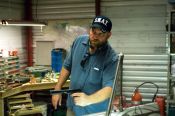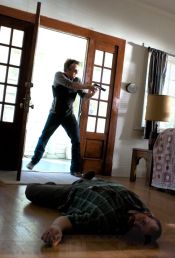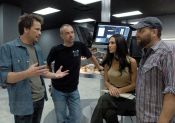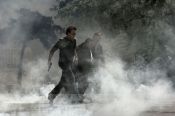
Director Robert Kurtzman setting up a shot (photos courtesy of MGM)
Robert Kurtzman is a make-up effects maestro, known by horror fans worldwide as the guy Hollywood goes to when they need to create special effects. Kurtzman has worked across many genres and he is responsible for some of the most memorable creations that have ever been committed to celluloid.
Eye For Film’s Darren Amner talked with Kurtzman about his career so far, the who’s who of horror legends that he’s worked with, his exciting new production company Precinct 13 and his upcoming directorial projects starring a young Indiana Jones and Jigsaw from the Saw franchise.
DA: Hi Robert. For over 20 years you've designed and created some of the most memorable special effects for many of Hollywood top directors. Can you tell us how you got into the business and what it was that initially drew you to do what you do today?
RK: I left Ohio in 1984 and moved to LA to attend Joe Blasco’s make-up academy, and started working at John Beuchler's MMI when I was 19 years old. I’d always been into art and movies since I was a little kid. I’d spent most of my youth sitting in front of the TV watching late night horror hosts and was drawn to fantastic cinema very early on. Special effects, make-up and creatures really caught my interest after I saw Planet Of The Apes, King Kong, One Million Years B.C. But it wasn’t until the Eighties when I saw Raiders Of The Lost Ark, John Carpenter’s The Thing, The Howling, American Werewolf, that I considered a career in special effects.
 |
| Sean Flanery enters house ready for action. |
RK: I love working on all kinds of films, big and small. The small films are more challenging as they have less of a budget to work with and so it's great having to be creative and think outside the box to be able to pull things off in a short time. You stay way busier on small films than on the big blockbusters. On big movies you do 10 -15 set ups a day but on a small picture that may only have a 25 day schedule you're always on the go, doing 40-50 sets ups a day. Evil Dead 2 and Army of Darkness were my favourite film experiences as far as the overall shoot and energy on set were concerned, and creatively From Dusk Till Dawn, Bride Of Re-Animator, Misery, Dances With Wolves, Gross Anatomy… there are so many films that were very challenging artistically.
DA: Being part of the legendary K.N.B effects company has lead you to work with a who’s who of directors in Hollywood. What were your experiences like working with these masters and what did you learn from your time on set with them?
RK: Wow! I’ve learned so much from all the filmmakers I’ve had the privilege of working with over the years. I’ve picked up so much from them all. I learned how a movie set works, how to break down and shot list a scene, storyboarding and doing overheads, where to put the cameras to get the coverage, how to build action and suspense, dealing with collaborative actors and those not so collaborative. I learned that even the biggest most successful filmmakers deal with a ton of pressure and bullshit no matter how much money their films make at the box office. The thing I learned from them all is how to think on my feet and roll with the punches… one day you're behind, the next day you catch up. Just don’t panic, keep moving ahead and do whatever it takes to get the job done.
On John Carpenter
I’ve been a huge JC fan since seeing Assault On Precinct 13. As a teen I couldn’t wait to see what John came out with next. Halloween, The Fog, Escape From New York, The Thing, Big Trouble In Little China… His films were very influential on me wanting to become a filmmaker so when I first worked with him on Body Bags it was a real thrill for me. I was a bit awestruck at first, until I realised how laid back he was… he’s a real genuine guy and a very loyal collaborator. We ended up doing numerous films with him and most of his crew had been with him for years. As a filmmaker he knows exactly what he wants and how to get it. He’s a great storyteller and knows how to stage awesome shots especially shooting anamorphic.
On Robert Rodriguez
What I love about Robert is how he approaches shooting. Anything goes and he’s not afraid to do unusual things to achieve what he’s looking for. From shooting in wheelchairs or on skateboards, he does whatever it takes to get energetic shots… I love shooting Guerrilla style so its was great watching Robert on set because he made up his own rules and did what he wanted.
On Quentin Tarantino
I first met QT after he was recommended to me as a possible writer to adapt my treatment for Dusk into a screenplay. At that time he was still working as a video store clerk and had no car. I would pick him up and drive him from Glendale were he lived with his mom to Chatsworth where our KNB studio was so we could hang out and talk movies. We grew up watching the same kind of films so when we started talking about Dusk and how it was a mix of Race With The Devil and The Getaway, with horror and vampires thrown in, we were both on the same page from the get go. We both loved drive-in films and he totally got why I called it From Dusk Till Dawn… When we were both growing up there were all night drive-ins and they would always say From Dusk Till Dawn – 5 movies all night on the marquee, so he got my title inspiration right away. Dusk was always intended to be a drive-in movie and I knew after hanging out that first day at my studio Quentin was the right guy to write the screenplay. His material was raw, edgy, and the dialogue was like nothing I’d ever read before.
On Wes Craven
As with John Carpenter I grew up watching Wes’ films as well. I was deep in the woods at Boy Scout camp when I first heard the spooky radio ads for The Hills Have Eyes and it freaked us all out. Years later I was on set with him on our first collaboration, The People Under The Stairs, and as with John Carpenter it was a dream come true. Wes is a very soft-spoken intelligent filmmaker. He doesn’t like unnecessary drama on set and is very assured. Like JC, Wes is very loyal to the people who support him and has worked with the same crew for years.
On Sam Raimi
Sam was a huge influence on me as a filmmaker. On Army Of Darkness he called me the young director in training as I would stage all these FX and puppet action in the background of shots.
Sam would ask what could be done to help him fill in the action so the shots always had something going on and I would block out all this puppet business very quickly within minutes. Sam liked to move fast and furious and we always had multiple units running with FX so it got really crazy at times, but it was a very adrenalin-fuelled set. I love Sam’s energy and his sense of humour because as intense as it sometimes gets on set, Sam always kept it light and fun. He’s very open to the creative process.
On Steven Spielberg
I met Mr. Spielberg in the mid Eighties at Amblin during prep on The Color Purple. I did all the lab work, life-casting, and sculpted on the various character make-ups. Unfortunately my contributions on the film went unaccredited as I wasn’t in the union and therefore couldn’t do set-work. This was pre-KNB and years later we ended up doing work on Amistad and Minority Report. Unfortunately I personally haven’t spent time onset with Mr. Spielberg as I was supervising on other projects at the time. His films had also been a big influence on me growing up. Raiders and Jaws are still two of my favourite films of all time. I saw Raiders ten times at the theatre and my dad was getting pissed because I kept asking for money to go see it over and over again. He asked why I don’t go see something new and I told him “I was studying it trying to figure out how they did it all”. After that he gave me the cash and never asked me again.
 |
| Sean Flanery, Producer David Greathouse, Actress Carmen Serano, Director Robert Kurtzman on location |
RK: Practical is always better than CGI because it's really there and the actors are interacting with something physical, but sometimes you have to use digital effects because there is no way to achieve it physically. You can’t actually make a dinosaur that flies or chases people down the street so it has to be done with animation.
Sometimes the schedule doesn’t allow for blood gags to be done practically because it will take three hours to clean up the mess and change the actor’s wardrobe and fix the blood stained make-up. When you're shooting on a 20 day schedule every minute counts.
DA: After honing your craft working in special effects you started to develop your own projects and the first major project you wrote and co-produced was From Dusk Till Dawn. It ended up becoming a trilogy - it’s a set of films I personally love and have watched many time as a fan. How happy were you with the final outcome for each of those films?
RK: I was very happy with how Dusk turned out as it was a labour of love for me that took me ten hard years of ups and downs to get made. Robert did a kickass job directing and Clooney was a great casting call. It was like having Steve McQueen in the film. As far as the sequels go I had no creative involvement other than the effects work. Scott Spiegel and PJ Pesce did great working on schedules and budgets that were less than a third of what the first film had, so for what they had to work with they turned out great, but obviously I have a soft spot for the first film.
DA: The Demolitionist was the first ever feature that you directed, which I believe was quite successful and was based on an original story. Tell us about making your first feature, what you enjoyed, what you found difficult and how your experiences making this film helped develop your skills as a new film-maker.
RK: While prepping Dusk I was approached by producer Don Borchers, whom I’d worked with and directed second unit FX for on a low budget movie with Drew Barrymore called Doppelganger. He was looking to do a small action sci fi film and asked if I had anything. I gave him a rough draft for a female vigilante picture I’d written with my wife and a piece of artwork for the lead character. Don liked the concept but he wanted it to have more of a sci-fi feel and he wanted it set in a bigger city and not small town America where we originally had it take place. Don took the artwork and the concept to A-Pic and Alliance Atlantis and set up the financing. Several weeks later we were in prep. We did it for a million dollars and shot it in 24 days in and around LA. It was an awesome experience and I had a blast. The biggest challenge was the budget and schedule. There was no money to do big set pieces so we had to be very frugal and carefully plan all the action set pieces as we had only hours to shoot them in. You have to think on your feet and roll with the punches. I only got 1,500 dollars to direct the picture and so I had to put some of the money I made from Dusk into building the Demolitionist costume, motorcycle, and guns. I really loved the guns we made for the film. They worked on gas and we built them around the same concept as the Logan's Run guns, only we built ours so they could fire rapidly like a machine gun.
DA: Next up was Wishmaster, this time with a bigger budget, which turned out to be a very successful independent horror/fantasy film that spawned several sequels and introduced a new horror icon, Djinn. What was it that drew you to this project?
RK: After Demolitionist I was looking for my next project and I wanted to do something bigger with a longer shooting schedule. Wishmaster was an open assignment and the producers were interviewing possible directors for the project. Sam Raimi had seen The Demolitionist and was impressed with what we did with little money and recommended me to producer Pierre David, who had been calling around looking for a hungry up and coming filmmaker to helm the picture. I really liked the concept and how the Djinn baited his victims into making wishes that he twisted around on them. I’d gone in for half a dozen meetings with the producers and the executives at Live/Artisan (now Lionsgate), each time pitching my take on how I’d approach the film and shooting. Eventually I was awarded the assignment and shortly afterwards Wes Craven came on board to executive produce and grandfather the picture based on our prior working relationship. It was an extremely satisfying experience. We shot in 33 days for six million dollars, which was well below the standard studio picture budget but it was a big step up for me.
DA: In 2003 you founded Precinct 13 Entertainment. Can you tell us about this exciting new company and what projects you have been a part of so far, and what are you currently developing?
RK: I left Hollywood and moved my family and my studio to Ohio where I grew up. I wanted to raise my kids outside of LA and I wanted to do more than just FX. I couldn’t really do that while at KNB. I wanted to get more involved with all aspects of filmmaking and not just make-up FX. I also wanted to explore CGI as well as the overall film production process. We’ve done special effects on Hostel, The Devil's Rejects, Buried Alive, Living Hell (aka Organizm), Wanted Undead Or Alive, Mad TV, Frank Miller’s The Spirit, Ghouls and Boogeyman 3, and have produced my film The Rage and the upcoming film Dead Matter, on which we handled all the production chores from the FX to set building. We’ve done several award winning commercials as well as music videos.
DA: Most horror fans know you have turned your hand to many things within the industry, from special effects to directing features and music videos. What aspect of movie-making do you enjoy the most, and is there any aspect of this creative process you have yet to try that you’d like to give a go?
RK: Directing is my favourite gig. I love doing the FX and designing creatures but there is nothing more fulfilling than directing for me.
DA: You recently completed principal photography on To Live And Die, which is a bit of a departure for you. Why did you choose this project and what can we expect from the final product when it arrives?
RK: I didn’t really choose the project… I was lucky enough the project came to me. I’d just done a film, Buried Alive, for the producer David Greathouse, and we got along incredibly well. Together we delivered Buried on schedule and budget on a 20 day shoot. Dave had set up the project, then called Angelmaker at MGM, and I was in LA posting The Rage which I shot only two weeks after wrapping the Buried shoot. I invited Dave over to the sound house to check out our low budget drive-in film and he was really impressed by the film's non-stop pacing and action and what we were able to do with no money. He suggested I do an action picture next and asked if I’d be interested in taking a look at To Live And Die. It’s an action thriller and sequel (in title only) to William Friedkin’s To Live And Die In L.A. It’s a tight little action picture with some great set pieces. It was a tough as hell shoot as we only had 25 days to pull it off. We shot in New Mexico in late summer and it was an incredible experience.
 |
| Sean Flanery in action |
RK: Sean was the first person I brought up for the role of Tom Armstrong, a tortured cop with a shattered past who gets a second chance to set things right. Sean is totally underrated and a consummate professional. I’ve been a fan of his for years and when I read the role I instantly thought of him. His performances in Boondock Saints and Powder blew me away, and he is really solid in everything he’s been in.
DA: Speaking of Bump, this project sounds really exciting. I believe you're currently in pre-production on this film. Can you tell us about the movie, its genesis and its current status?
RK: I’m very excited about Bump. We are getting close to starting pre production and plan to shoot later in the summer. Producer Scott Licina and comic creator Mark Kidwell gave me the comic treatment to look at, which really blew me away… I immediately asked if I could direct. We’ve been working on getting the film put together ever since. We’ve brought in Tobin, Sean, and Ashley Laurence and will finish out casting shortly. The FX work is substantial and P13’s Creature Crew will be handling the FX.
DA: Finally, if you could cast any actor in a dream project of yours who would it be and why?
RK: Dead – Charles Bronson, Steve McQueen. Alive – George Clooney, Clint Eastwood.
Eye For Film would like to thank Robert for taking the time to do this interview. For further information on upcoming projects please check out the Precinct 13 website http://www.p13entertainment.com or for news on Bump please check out the movies website http://www.bumpmovie.com





















